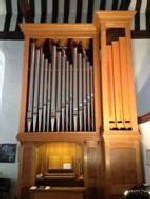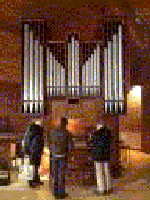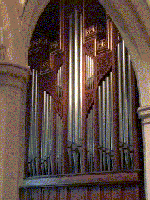Trip to Guildford and Godalming
Saturday 4th February 2012 dawned bright and very cold, and saw a small but hardy band of SSLSO members making their way towards Guildford by car and train. Setting out from home, I noticed the temperature was showing as -5c, although on arrival in Guildford less than an hour later it had warmed up to a balmy -2c.
St Mary’s Quarry Street, Guilford.
 At 10am, we arrived at the church of St Mary, Quarry Street where we were met by the Organist and Choirmaster, Steven Salmon. Steven gave us a brief history of St Mary’s, which is the oldest church in Guildford, there having been a church on the site since the 10th century. It is also the oldest building in Guildford which is still being used for the purpose for which it was originally designed. Since the 10th century the church has grown, with the addition of a nave, aisles, transepts and chapels, although much of the ground is unlevel and there is hardly a straight line anywhere in the building. Steven commented that a marble placed on the floor at the high altar will quickly roll to the other end of the building.
At 10am, we arrived at the church of St Mary, Quarry Street where we were met by the Organist and Choirmaster, Steven Salmon. Steven gave us a brief history of St Mary’s, which is the oldest church in Guildford, there having been a church on the site since the 10th century. It is also the oldest building in Guildford which is still being used for the purpose for which it was originally designed. Since the 10th century the church has grown, with the addition of a nave, aisles, transepts and chapels, although much of the ground is unlevel and there is hardly a straight line anywhere in the building. Steven commented that a marble placed on the floor at the high altar will quickly roll to the other end of the building.
Steven then related how the previous organ in the church had been destroyed in a fire, which led to the installation of the current instrument in 1988. Designed and built by Saxon Aldred of Redbourne, Hertfordshire, the mechanical action organ has 2 manuals and pedals with 16 speaking stops and the usual couplers. Steven also pointed out that since 1988, a Bombarde 16’ and an Open Flute 4’ had been added to the pedal organ, which greatly added to the versatility of the instrument. Steven then demonstrated the organ to us by playing works by Stanley Vann and Zachau, after which members were invited to play the organ for themselves. The organ displayed some lovely sounds, particularly the bright flutes and the clear unforced tone of the Great principal chorus topped by a Mixture IV rks. We found the action to be light and responsive, and the bright sound projected clearly into the church, no doubt aided by the very shallow case and floors unadorned by carpet. All present agreed that the organ was a delight to see, play and hear.
Organ installed in 1988 by Saxon Aldred
Organ Specification
Pedal – Subbass 16’, Gedact 8’, Open Flute 4’, Bombarde 16’
Great – Open Diapason 8’, Stopped Diapason 8’, Principal 4’, Rohr Flute 4′, Gemshorn 2’, Sesquialtera II, Mixture IV
Swell – Chimney Flute 8’, Gemshorn 4’, Octave 2’, Acuta II, Cremona 8’, Tremulant
Usual couplers by toe pedals
Temperament – Werckmeister II
Roman catholic church of St Joseph
 After a short walk up the High Street we arrived at our next venue, the Roman Catholic church of St Joseph, just before midday. The first Roman Catholic church of St Joseph was built in 1860, although the current building dates from 1984. The mechanical action organ, which has 2 manuals and pedals with 16 speaking stops and the usual couplers, was built by N P Mander in 1982, for installation in a large Catholic church in Lagos, Nigeria.
After a short walk up the High Street we arrived at our next venue, the Roman Catholic church of St Joseph, just before midday. The first Roman Catholic church of St Joseph was built in 1860, although the current building dates from 1984. The mechanical action organ, which has 2 manuals and pedals with 16 speaking stops and the usual couplers, was built by N P Mander in 1982, for installation in a large Catholic church in Lagos, Nigeria.
We were met by the organist, James Berry, who described how his predecessor Michael Davis was appointed organist in 1983, while the new church was still under construction. At this time Canon Patrick Cox was the parish priest, and the possibility of installing an Allen electronic organ in the new church was being discussed. However Michael Davis was keen for the parish to acquire a pipe organ, and decided to make enquiries with Noel Mander in order to get some idea of the likely cost. Mander told him that the Lagos organ project had fallen through because the church had been unable to get the money out of the country. On learning this Michael Davis and Canon Cox visited Mander’s factory, where Canon Cox was able to acquire the instrument after negotiating a substantial discount. It was then put into storage in a warehouse in Guildford, and finally installed in the church around six months after the building was completed in 1984. James went on to say that Ian Bell believes that the organ had been designed by him, that it had been voiced “all out” in recognition of vigorous Nigerian singing, and that the mechanisms were built with strength, rather than delicacy, in mind. The organ is a self-contained and free-standing instrument which speaks unhindered into the church, although the casework is of quite squat proportions.
James then demonstrated the organ to us. Two pieces by Dandrieu – Basse et Dessus de Trompète and Flûtes – showed off the Great Trumpet and flutes to good effect. James explained that the reeds have open shallots, which results in a freer tone. James then played J S Bach’s Fugue on the Magnificat BWV733, which showed off the plenum, crowned by a fine full length Trombone 16’ on the pedals. Members were then given the opportunity to play the organ for themselves, and various registrations were explored. The organ sounded very fine in the church, with a warm and unforced tone, and although the action was heavier than that at Quarry Street, it did not detract from the pleasure of playing the instrument.
The Parish church of St Peter & St Paul in Godalmin
 Our last visit was to the Parish church of St Peter & St Paul in Godalming, a short drive from Guildford. After lunch we arrived at the church at 2.30pm, where we were met by the Organist and Choirmaster, John Belcher. John welcomed those present, and gave us a brief history of the church and the organ. The first organ in the church was a two manual instrument by Flight & Robinson, which was installed in a west end gallery in 1829. This instrument was enlarged by having pedals added, and was subsequently relocated to the north transept during church renovations in 1840. The organ was later sold to the church of St John, Fitzroy Square, London. The current instrument, by William Hill, dates from 1887 and is also installed in the north transept.
Our last visit was to the Parish church of St Peter & St Paul in Godalming, a short drive from Guildford. After lunch we arrived at the church at 2.30pm, where we were met by the Organist and Choirmaster, John Belcher. John welcomed those present, and gave us a brief history of the church and the organ. The first organ in the church was a two manual instrument by Flight & Robinson, which was installed in a west end gallery in 1829. This instrument was enlarged by having pedals added, and was subsequently relocated to the north transept during church renovations in 1840. The organ was later sold to the church of St John, Fitzroy Square, London. The current instrument, by William Hill, dates from 1887 and is also installed in the north transept.
The blower at this time was hydraulic, but this was never satisfactory due to the low water pressure in the area. Further work was carried out in 1911 by Brindley & Foster, who added various ranks and a Chancel Great section, and in 1961 by Hill Norman and Beard, who changed the action from Tubular Pneumatic to Electro Pneumatic, carried out various repairs and moved the Choir Clarinet to the Swell, replacing it with a Nazard. In 1999 the firm of F. H. Browne reconstructed the console, swell box and the Choir and Chancel Great soundboards, as well as adding a new solid state combination action. The Clarinet was moved from the swell box, where it had been almost inaudible, and back onto the Choir, where it can be heard to best advantage.
(For specification, please see record D08367 at the National Pipe Organ Register).
In 2003 two 32’ digital ranks were added to the Pedal organ, and a Vox Humana 8’ has also been added to the Swell. At 48 speaking stops, the organ is now the second largest in the county, second only to Guildford Cathedral.
John then demonstrated the organ to us, playing the first movement of Walther’s Concerto in B minor and Rhapsodie No.3 by Saint-Saëns. The first work demonstrated clear Principal choruses on contrasting manuals, while the second showed off many off the quieter ranks, including the Clarinet 8’, as well as the resources of the full organ. Members then played the organ for themselves, and enjoyed taking the time to try out various combinations of strings, flutes and reeds. In particular, it was found that the two digital 32’ registers were remarkably effective when used in combination with the full organ. After nearly two hours at Godalming, we made our way home after a very enjoyable day. As well as thanking our hosts for giving their time so generously and ensuring that each venue was heated, particular thanks are due to our member Mark Edwards, who organised the day on our behalf.
Graham Powell

